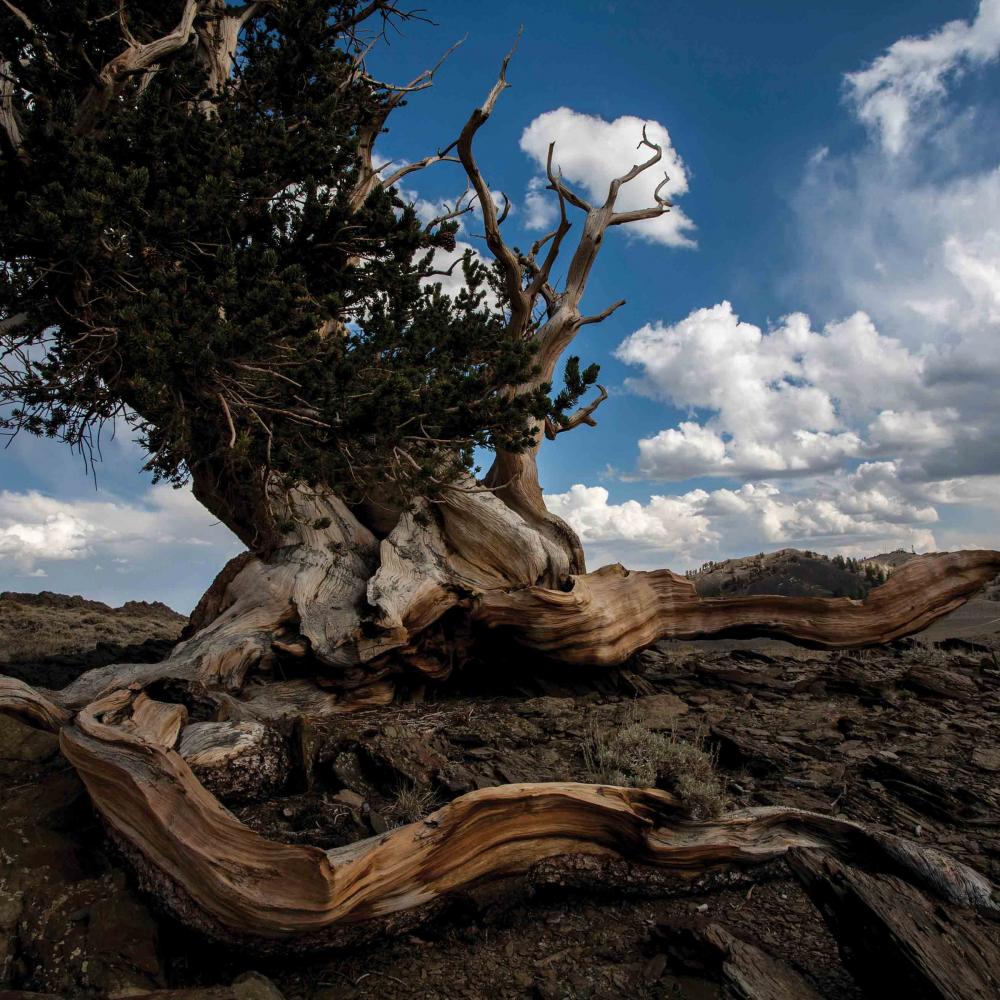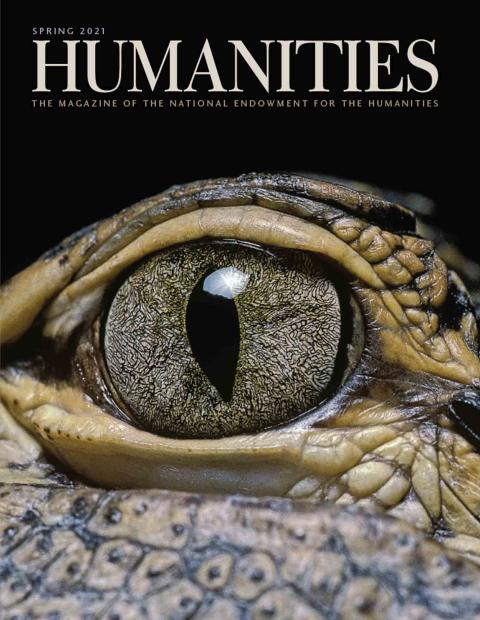Jared Farmer is a professor of history at the University of Pennsylvania and the recipient of an NEH Public Scholars grant to support his forthcoming book, Survival of the Oldest: Ancient Trees in Modern Times (Basic Books). He is the recipient of several prestigious awards, including the Francis Parkman Prize from the Society of American Historians for his 2008 book, On Zion’s Mount: Mormons, Indians, and the American Landscape. His last book, Trees in Paradise, told the modern history of California through the history of its treescape.
HUMANITIES: You call yourself a “geohumanist,” which is what exactly?
JARED FARMER: Well, it’s a nifty Instagram handle! Seriously, though, I devised this neologism to succinctly express my deepest scholarly commitments. “Environmental historian” never sounded quite right to my ears. I wanted a single word that worked multiple ways. First, a word that put Earth first, literally, not in an antihuman or even ecocentric sense but in simple recognition that this perfect planet is precedent to humanity. Second, a word that suggested that geoscience is essential to the humanist project—and vice versa. Third, a word that implied that global warming, global governance, and geoengineering are unsolvable problems without the humanities.
HUMANITIES: I think you are also known in some circles as “the tree guy.” How come?
FARMER: With Trees in Paradise, I thought I had written a history of California with trees, but some readers received it as the definitive history of California’s trees, and folks began calling me “the tree guy,” and, soon enough, they expected me to be able to identify, at a glance, the binomial of any plant, even on the East Coast! I was flattered, though slightly annoyed at first. I wondered if this formulation was a subconscious belittlement of trees as objects of serious historical study. Would anyone call a scholar who studied financial history “the capitalism guy”? Also, would I still be “the tree guy” if I didn’t present as a man? It’s unfortunately true that arboriculture and forestry and dendrochronology are historically male-gendered areas of knowledge—more so than the larger field of botany. Of course, in our current linguistic moment, “guy” can be gender neutral or highly masculinized, depending on context. In any case, I eventually embraced “tree guy,” because, to my own surprise, this California historian became a tree-hugger—so much so that I’m now writing a book about trees.
HUMANITIES: Speaking of trees, I have this thing in my backyard. It’s pretty tall and it has bark and branches, but my neighbor (he’s a gardener) calls it a weed. He’s wrong about my tree, isn’t he?
FARMER: You’re both right! Neither “tree” nor “weed” is a scientific term. A tree is a plant that people call a tree. A weed is a plant that people consider out of place. Both terms are culturally determined, historically variable, and site specific. That being said, “tree” can be legally defined, which sometimes comes up in court. In my experience, all Americans love trees—except for the ones that negatively affect property use and real estate value. I hope you and your neighbor can agree to disagree!
HUMANITIES: Your book On Zion’s Mount tells Utah history and Great Basin history through the landscape. It contains a very compelling narrative of the Mormon migration and later twentieth-century history, including Robert Redford and Sundance, but the book as a whole is structured to reveal as much as possible about landscapes. And in an interview you said, “There is no such thing as an innocent landscape.” What did you mean by that, and can you summarize the argument of On Zion’s Mount?
FARMER: Outside Antarctica and a few islands groups, there’s been no unknown, unoccupied, unstoried land for millennia. Therefore, every act of place-making has been an act of remaking, if not encroachment or outright displacement. “Sense of place,” an ethic that seems so benevolent, can conceal histories and legacies of violence. My comment about innocence applies generally, but specifically I was speaking about landscapes of “settler colonialism”—the phrase historians now often use in place of “settlement” or “pioneering.” The Beehive State commemorates pioneering more than any U.S. state—so much so that Pioneer Day (July 24) ranks above the Fourth of July. Much like white evangelicals tend to think of America as an exceptional, providential, and innocent nation, Utah Mormons tend to think of their ancestors as the most exceptional, most providential, and most innocent Americans—the one group of settlers who managed to make the “wilderness” bloom without any malice or injury to Indigenous peoples. That’s simply not true.
My main argument goes like this: Utah history, despite being unusual, even weird, in the religious details, is pretty conventional in the broad outlines and violent outcomes of settler colonialism. Nineteenth-century Mormons dispossessed Utes and erased their landscapes, and then twentieth-century Utah Mormons invented place-based legends about imaginary Indian princesses, instead of remembering what actually took place. That’s as American as it gets.
HUMANITIES: You grew up in Utah and are the product of Mormonism, but I get the feeling you have a complicated relationship to both. How does your religious and cultural background play into your work? Or, to put the question less personally, how does religion figure into the kind of environmental humanities that you practice?
FARMER: Yeah, it’s complicated. I no longer belong in my place of belonging. In sensibility, I remain a Utah Mormon, I suppose, because all my work concerns sacred space and sacred sites. Or, more accurately, I study how people have sacralized and desacralized landforms (including trees) as they have changed landscapes. Intellectually, I do feel kinship with religious studies. In religious terms, I’m not a theist, and not a deist, yet somehow I failed to convert to the New Atheism. I accept religion as a persistent feature of humanity, and look for common ground with those who see divine goodness in the Earth. I’m certainly not a Gaian—the geologic record contains too many mass extinctions for me to go there—but I do believe that earthly life has purpose beyond human perception. Basically, I don’t need any supernaturalism to be wonderstruck by this rarest of planets. Voicing praise and giving thanks for the gift of the biosphere—miracle of miracles!—seems supremely rational to me.
HUMANITIES: Trees in Paradise is a history of modern California told through four kinds of trees: redwoods, eucalypts, citruses, and palms. It’s a story, in part, about beautiful plant life and its destruction. But you call California Edenic. Will California long be able to consider itself a paradise?
FARMER: For the narrator’s voice of that book, I self-consciously—and semi-ironically—echoed nineteenth-century boosters of California. But sure, if the Golden State is the Garden, it’s a strange kind of Eden—perennially in danger from acts of an angry god who would burn it down, or cast it into the sea.
Speaking historically, the bloom is off California. Incredible treescapes that twentieth-century Californians knew and loved and took for granted are now senescent and unsustainable. The state’s infrastructure—including commercial orchards and urban forests—was designed when California had more water, and fewer residents by tens of millions. So, what happens now as the regional climate becomes hotter and drier? Many ancient trees will die, and certain iconic megaflora will no longer grow in familiar habitats. The fires will keep coming. Over time, forest cover will get shorter and shrubbier. All that being said, I suspect that California will remain gloriously beautiful, floristically unrivaled, and culturally vibrant. Cities can and must adapt. As someone who loves L.A., I refuse to count it out.
HUMANITIES: You take a surprising view of what people call “invasive species.” For instance, like a lot of people who live there, eucalyptus trees are not native to California. But you are not exactly disapproving. Why not?
FARMER: Because the smell brings back childhood memories of visiting grandparents in L.A.? Because I’m contrarian?
According to ecologists, an “invasive species” spreads rapidly and extensively, thereby causing ecological transformation. Any species, even a “native” one, can become invasive under optimal conditions. That’s part of evolutionary history. I’m using scare quotes because these keywords are contested and context-specific. If a “species” (itself a slippery concept) invades in one place at one time, that’s not predictive of all places at all times. Whether people consider a floral “bioinvasion” a problem depends on whether they consider the invasive plant a “weed,” and that consideration depends on aesthetic, cultural, and economic factors. Weeds are usually conceived as accidental introductions—or purposeful ones that went awry.
In late twentieth-century California, mature eucs suddenly went from beloved and adopted to reviled and disowned, though they still have defenders—sometimes overzealous defenders. Myself, I wouldn’t want to live in the current Berkeley Hills—that population of trees is a fire hazard—but I argue that the evils attributed to eucs at the species level are often exaggerated or fabulated. The just-so story about their toxic chemicals inhibiting neighboring life just ain’t so. Besides, of the many eucalyptus species in California, only one (E. globulus) has been invasive, and only moderately so, and only in the select habitat of the fog belt of the central coast, and only there after people gave it an extraordinary jump start by creating get-rich-quick-plantations.
Eucalyptus trees exist in California because past Californians desired them and seeded them, not because eucs somehow possessed land on their own. In retrospect, introducing them was a mistake—a beautiful, long-lasting mistake. But long-lasting doesn’t mean forever: The ongoing megadrought is doing a number on them. For the time being, the survivors are pungent reminders of an exuberant period in Golden State history.
HUMANITIES: At the American Academy in Berlin you gave an excellent talk on the history of forest preservation and national parks and what we might call environmental education for the young. What do you think are some of the key components that should go into teaching the young about nature?
FARMER: Childhood education lies outside my formal training, but here’s my gut response: If at all possible, teach local, and teach outside. The nonhuman world, unmediated by screens, is inherently wondrous to little humans. See the world at their level: They have so much to teach us! But even naturally nature-loving children need adults to model knowledge-seeking, reverence, and care for the more-than-human world. Tots learn first by watching us. As for grade schoolers and upper schoolers, what’s striking and dismaying to me is the absence of experiential nature learning from STEM education in the United States. We tell young people to study science, and we leave it to them to “save the Earth,” but we hardly teach them anything about ecological networks and geophysical processes that surround them. Nature remains “out there” in “wild Africa” or somewhere equally remote. I’m not endorsing Prussian-style Heimatkunde, but I do think localism, bioregionalism, and subnationalism remain vital to environmental ethics. Cosmopolitanism gets you only so far. The climate crisis is global, but most people experience it locally. For teachers, the goal should be cultivating a critical sense of place.
HUMANITIES: Richard Powers’s novel The Overstory is about trees. It won the Pulitzer Prize a couple years ago, and sat on the New York Times best-seller list for a year, causing more people than usual to be reading and thinking about trees. Tell me, what do you think of The Overstory?
FARMER: Honestly, I was surprised that a nerdy novel about trees did so well! I really can’t explain it, especially when Annie Proulx’s tree-themed Barkskins, published about the same time, didn’t have nearly the impact. Personally, I found the second half of Overstory less interesting than the first. In part, that’s because the book becomes a fictionalization of historical events I covered in Trees in Paradise. The larger reason is that the book becomes more character-driven as it goes along, and more conventionally novelistic. And, believe it or not, I found the humans less compelling than the trees! To me, the best “character” in the book was the Hoel family chestnut. The opening chapter of Overstory, centered on this chestnut, is brilliant—one of the best answers I’ve read to Amitav Ghosh’s call for fictions with more-than-human temporalities. Maybe Powers couldn’t figure out how to sustain that? As long as he was playing around with genre, I do wish he had included a bibliography. It’s too bad that forestry ecologist Suzanne Simard (the main inspiration for a major character) goes unacknowledged in his book.
HUMANITIES: Can we talk about time and age? What kind of trees are the oldest? Also, does it matter? Are there important things we can learn by contemplating trees and their age?
FARMER: My forthcoming NEH-supported book, Survival of the Oldest, takes up such questions. The identity of the world’s oldest living tree is unknowable, and frankly doesn’t matter. But the one you’ll find in the record books is a Great Basin bristlecone pine (Pinus longaeva) in the White Mountains of eastern California. Bristlecones are remarkable plants, and they allow tree-ring scientists to calibrate radiocarbon age determinations, reconstruct past climates, and even provide dates for supervolcanic eruptions and cosmic radiation events. Amazing! In general, gymnosperms (conifers, cycads, ginkgoes) live longer than angiosperms; and highly resinous conifers such as bristlecones live the longest—up to 5,000 years—especially in cold, dry, unproductive, low-competition environments. There’s a maxim for this paradox: “Longevity under adversity.” Various other plants can restart or prolong life through regeneration or self-cloning. Scientists locate oldest living things all the time.
For my purposes, the never-ending search for the oldest is simply a convenient narrative structure. What really interests me is how long-lived plants allow humans to think about—and emotionally relate to—long units of time. They provide a bridge between human time and geological time. Given that anthropogenic climate change will have effects deep into the future, people need to get better at long-term thinking—even as attention spans get shorter and shorter. Basically, I’m wondering if trees can help us plan for longevity under precarity.
HUMANITIES: You recently took a position at the University of Pennsylvania where you developed a course called “Petrosylvania.” What do students learn in this course?
FARMER: It’s both a historical methods course and a local history research collaboration that will result in a digital humanities project. I start with the premise that fossil fuel powered the making—and now the unmaking—of the modern world. Pennsylvania was the first fossil-fuel state in America, complete with gushers, and it was the second fossil-fuel polity after Great Britain. Its coal and its oil led the United States toward an energy-intensive economy, a technological pathway that’s had planetary consequences. One of the oldest and longest-operating refineries in the United States—shuttered in 2019 after a near-disastrous explosion—sits a couple miles southwest of Center City, Philadelphia, where I now live. Moreover, Penn’s rise as a well-endowed research university owed a lot to anthracite interests and the railroads that transported the coal.
In 2023 or 2024, I and my student collaborators will present our historical accounting—a kind of ethical reckoning—of fossil fuel in relation to Penn and Philly. In recent years, many universities have sponsored studies on their institutional connections to slavery, or scientific racism, or Indigenous dispossession. And there are numerous memos and commentaries about fossil-fuel divestment. But, to my knowledge, no university has generated a project like the one I and my students are doing at Penn.




